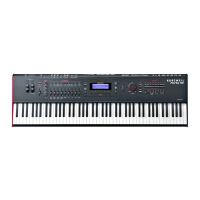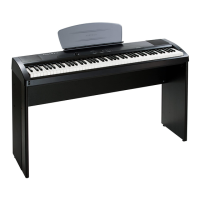Program Edit Mode
The LFO+ Page
3-66
The LFO+ Page
Use the LFO+ page to adjust LFOs, ASRs, and FUNs for each layer.
LFO Parameters
LFOs are low-frequency oscillators, periodic (repeating) control sources. LFOs are used to
repeatedly modulate a parameter based on the shape and frequency of an audio waveform.
You can control the LFO rate in real time (which denes how frequently the LFO repeats)
in Hz, or in note values in order to sync with the program tempo. You can also select from
many wave shapes, which denes the waveform of the modulation signal.
LFOs are commonly used for creating eects like vibrato (cyclic variation in pitch) and
tremolo (cyclic variation in amplitude). Each LFO must be assigned to control some
parameter before you’ll hear the eect.
LFO1 is always local, meaning that it’s triggered with each Note On event, and runs
independently for each note in the layer.
LFO2 is local by default, but can be made global by setting the Common page Globals
parameter to On. Global LFOs uniformly aect every note in each layer, and start running as
soon as the program containing them is selected, even if you don’t play any notes.
Minimum Rate
e MnRate parameter sets the slowest rate at which the LFO runs. Each LFO runs at the
minimum rate when its RateCt parameter is set to OFF, or when the control source assigned
to RateCt is at its minimum value.
e values 1/4 nt, 1/8 nt, 1/8 tr, and 1/16 nt will sync the Minimum Rate with the program
tempo (see “Tempo” on page 3-23 for details). When a note value is selected, the LFO rate is
xed, and the MaxRate and RateCt eld are hidden.

